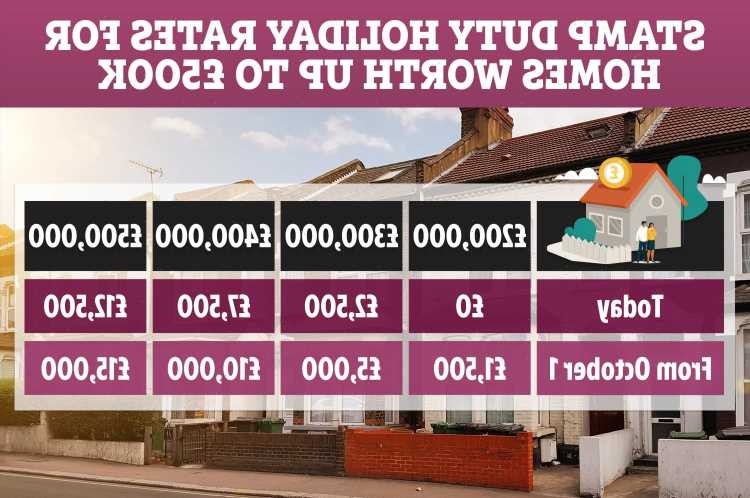THE full stamp duty holiday came to an end in July, but homebuyers can still benefit from reduced rates.
People have been saving money thanks to the temporary scheme that was introduced because of the coronavirus pandemic.

? Read our coronavirus live blog for the latest updates
The saving was designed to boost the property market which almost came to a standstill when the pandemic first hit.
At the beginning of the crisis, property prices fell for the first time in eight years and the housing market stalled.
But house pricesrocketed once the tax break was introduced, with buyers scrambling to save thousands of pounds before the deadline.
Even though the full holiday has now ended, the scheme is being phased out, which means you could still pay less stamp duty as long as you complete before October 1.
Here's everything you need to know.
When does the stamp duty holiday end?
The stamp duty holiday was originally due to end in March but the deadline was extended by three months, to June 30 2021.
Now,the tax-free threshold is set at £250,000, which is double the normal allowance until the end of September.
The stamp duty rate will then return to its normal limit at £125,000 from October 1.
What is stamp duty?
STAMP duty land tax (SDLT) is a lump sum payment anyone buying a property or piece of land over a certain price has to pay.
Up until July 8 2020, most house-buyers in England and Northern Ireland had to pay stamp duty on properties over £125,000.
This was temporarily increased to £500,000 until March 31, 2021 in the government's mini-Budget in July 2020.
The Chancellor extended the help until September 2021 in his Spring Budget.
The holiday has now been reduced to £250,000 as of the beginning of July 2021.
The rate a buyer has to fork out varies depending on the price and type of property.
Rates are different depending on whether it is residential, a second home or buy-to-let, or whether you're a first-time buyer.
The usual system in England for residential properties means:
- First-time buyers pay nothing on properties below £300,000 (and relief available on properties of up to £500,000)
- You pay nothing if the property costs below £125,000
- You pay 2% if it is worth between £125,001 and £250,000
- You pay 5% if between £250,001 and up to £925,000
- You pay 10% if it is between £925,001 and £1.5million
- You pay 12% on anything over £1.5million
For second homes or buy to let properties:
- 3% on purchases up to 125,000
- 5% on purchases between £125,001 and £250,000
- 8% on purchases above £250,001 and £925,000
- 13% on purchases above £925,001 and £1.5 million
- 15% on purchases above £1.5 million
Stamp duty rates are different in Scotland and Wales.
How does the stamp duty holiday help the economy?
The Treasury announced the stamp duty holiday in a bid to breathe life into the property market after it effectively froze during the first lockdown with viewings, sales and moves suspended.
Experts said a the holiday would encourage more home owners to move, helping to kickstart economic activity in other sectors.
Recent data from HMRC shows stamp duty receipts hit £6.7billion by the end of January.
This means the government tax take for the four months before that are at 82% of normal levels in comparison to previous years despite the holiday.
Speaking at the time the tax relief was revealed, Paul Johnson, director of the Institute for Fiscal Studies, told The Times there was a "good chance" that the policy would benefit the economy in the short term.
He said: "The housing market is very thin… Anything which gets it moving would potentially help."
But even though the nine-month stamp duty holiday has sparked a boom in the housing market, it has cost taxpayers billions.
And now there are fears that the property prices could fall as the holiday ends, even leaving some buyers in negative equity where the house ends up worth less than it was bought for.
How much money could you save on stamp duty with the holiday?
The average house cost £248,000 in England in March 2020, according to the Office for National Statistics (ONS).
If you purchased a home worth that much as a first-time buyer, you wouldn't have to pay any stamp duty thanks to the relief on homes below £250,000 that's in place at the moment.
From October, you would have to pay £2,460, because only properties worth £125,000 or less will be stamp duty free,
Brits buying a second home for the average price tag would save a whopping £9,900.
Home buyers who purchase a property before the end of September will save £2,500 on homes worth both £300,000 and £500,000.
You can calculate how much stamp duty you currently have to pay on the Money Advice Service website.
The government also has a handy calculator that tells you how much you would pay on a property.
Here's how you can get on the property ladder with just a 5% deposit by using the new Help to Buy equity loan.
Alternatively, the government is launching a mortgage guarantee scheme for buyers with the same-sized deposits.
Check out our guide to buying your first home, including how much you can borrow and the help available.
Source: Read Full Article
